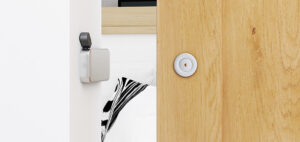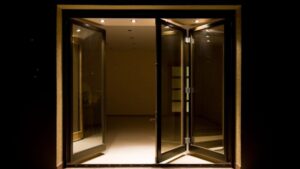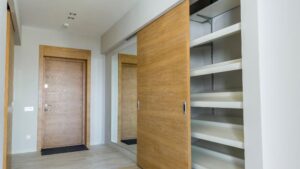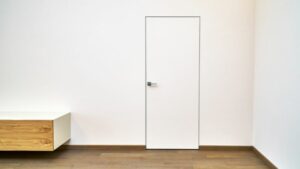The right wooden door enhances both your home’s look and functionality. Wooden doors bring natural beauty and warmth while offering durability and insulation benefits.
From solid wood to engineered options, hollow core to wood veneer, each type has distinct advantages in terms of cost, insulation, and appearance. Whether you prefer classic oak, elegant mahogany, rustic pine, or modern bamboo, understanding these differences helps you make the best choice for your needs and budget.
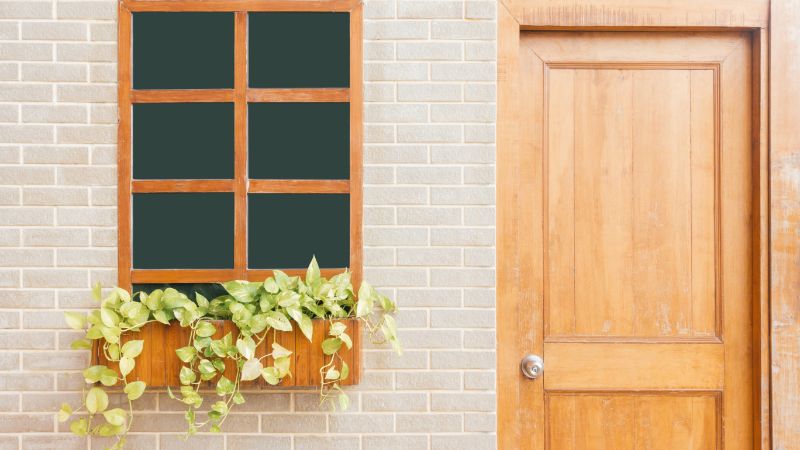
Overview of Wooden Door Types
Wooden doors remain a popular choice for homes. They come in three main categories.
Solid Wood Doors
Solid wood doors represent the premium option in wooden door construction. These doors are crafted entirely from natural wood, either as a single slab or multiple pieces joined together. Common woods used include oak, maple, cherry, and walnut, each bringing unique grain patterns and coloration.
The advantages of solid wood doors are numerous. They offer exceptional durability, often lasting for decades with proper care. Their natural thermal and sound insulation properties are superior to many alternatives.
Key benefits:
- Outstanding aesthetic appeal with natural grain patterns
- Excellent durability and longevity
- Superior sound insulation
- Can be refinished multiple times
However, solid wood doors typically come at a higher price point. They may also expand or contract with humidity changes, requiring periodic maintenance to prevent warping.
Engineered Wood Doors
Engineered wood doors provide an excellent middle-ground option between solid wood and hollow core doors. These doors feature a core made of wood composite materials or particleboard, covered with real wood veneer on the exterior surfaces.
This construction method offers enhanced stability compared to solid wood. The engineered core resists warping and dimensional changes caused by humidity fluctuations, making these doors particularly suitable for bathrooms and exterior applications.
Characteristics of engineered doors:
- More stable in varying environmental conditions
- Less expensive than solid wood options
- Real wood appearance with veneer surface
- Good insulation properties
The wood veneer exterior can be stained or painted just like solid wood, giving homeowners design flexibility. These doors typically weigh less than solid wood but more than hollow core varieties.
Hollow Core Wooden Doors
Hollow core doors represent the most economical wooden door option. Despite the name, these doors aren’t completely hollow. They contain a framework of wood with honeycomb cardboard or foam filling, covered with thin wood veneer or laminate.
These lightweight doors are easy to install and maneuver. Their affordable price point makes them popular choices for interior applications where sound insulation isn’t a primary concern.
Common applications:
- Bedrooms
- Closets
- Pantries
- Interior hallways
While hollow core doors don’t provide the same level of durability or sound dampening as their solid counterparts, they perform adequately in many residential settings. They resist warping better than solid wood but may be more susceptible to damage from impacts.
Modern manufacturing techniques have improved their appearance, with many styles convincingly mimicking the look of solid wood doors at a fraction of the cost.
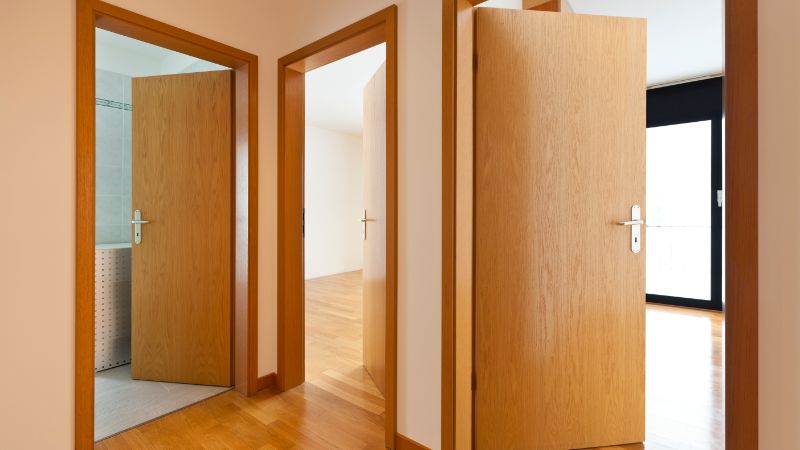
Panel Door Varieties
Panel doors offer a timeless appeal while providing numerous design options for homeowners. These versatile doors feature sections or “panels” set within a frame, creating visual interest and architectural character in any space.
Traditional Panel Doors
Traditional panel doors feature recessed rectangular panels arranged in various configurations. Commonly available in four, six, or eight panel designs, these doors complement classic home styles like Colonial, Victorian, and Craftsman.
The panels are typically arranged symmetrically, creating a balanced appearance that has remained popular for centuries. Wood species like oak, maple, and cherry are frequently used for these doors, each bringing its unique grain pattern and color.
Traditional panel doors provide excellent sound insulation compared to hollow core alternatives. Many manufacturers offer these doors with authentic wood construction or more affordable engineered wood options that resist warping and splitting.
Raised Panel Doors
Raised panel doors feature panels that project outward from the door surface, creating dimensional depth. This style dates back to colonial America but remains popular in contemporary homes seeking a touch of elegance.
The raised center portion of each panel sits higher than the surrounding frame, creating appealing shadow lines and visual texture. These doors typically cost more than flat panel alternatives due to the additional craftsmanship involved.
Raised panel doors work beautifully in formal spaces like dining rooms and master bedrooms. They’re available in various wood species and can be painted or stained to match interior décor. Many homeowners choose raised panel doors for their ability to add architectural interest without overwhelming a space.
Flat Panel Doors
Flat panel doors feature smooth, level panels set within the door frame. This clean, streamlined design makes them perfect for modern and minimalist interiors where simplicity is valued.
These doors typically feature sharp, geometric lines with panels that sit flush with or slightly recessed from the surrounding frame. They’re often constructed from maple, birch, or MDF to maintain their smooth appearance.
Flat panel doors tend to be more affordable than raised panel alternatives while still offering visual interest. They’re particularly popular in contemporary homes, apartments, and offices where clean lines are preferred. Many manufacturers offer these doors with various panel configurations, allowing homeowners to find the perfect balance between simplicity and visual texture.
Flush Wooden Doors
Flush wooden doors feature smooth, flat surfaces that create a sleek, contemporary look in any space. These versatile doors come in several varieties that balance aesthetics, durability, and cost-effectiveness for different applications.
Plain Flush Doors
Plain flush doors consist of a simple frame filled with a solid or hollow core and covered with plywood or MDF facing on both sides. The core typically uses a honeycomb paper structure, particleboard, or solid wood blocks depending on the desired weight and insulation properties.
These doors are among the most economical options in the flush door category. Their straightforward construction makes them lightweight and easy to install, particularly in interior residential settings.
Plain flush doors accept paint well, allowing them to blend with any decor scheme. While not as durable as other variants, they perform adequately in low-moisture, moderate-use environments.
Common applications:
- Bedroom entrances
- Closets
- Pantries
- Basement rooms
Laminated Flush Doors
Laminated flush doors feature high-pressure laminates (HPL) or low-pressure laminates (LPL) bonded to the door surface. This construction creates a highly durable, moisture-resistant finish that withstands heavy use and cleaning.
The laminate layer comes in countless colors, patterns, and textures, including wood grain simulations. This versatility makes them popular in commercial and high-traffic residential settings.
These doors resist scratches, stains, and fading better than painted options. Their sealed surfaces also make them more suitable for bathrooms, kitchens, and other areas exposed to moisture or temperature fluctuations.
Key benefits:
- Water resistance
- Impact resistance
- Low maintenance
- Color/pattern consistency
- Hygienic (antimicrobial options available)
Veneered Flush Doors
Veneered flush doors showcase the natural beauty of real wood with thin slices of premium timber applied to the door’s surface. These veneers typically range from 0.6mm to 0.8mm in thickness and are carefully selected for grain pattern and color consistency.
Popular veneer species include oak, maple, cherry, walnut, and mahogany. Each brings unique characteristics in terms of grain pattern, color, and texture. Wood veneers add warmth and elegance that synthetic materials can’t fully replicate.
Unlike solid wood doors, veneered options resist warping and offer dimensional stability. They provide a luxurious appearance at a more moderate price point than solid hardwood alternatives.
The core construction varies from engineered wood to solid timber frames with various fill materials. Higher-end models use fire-resistant cores or soundproofing materials for specialized applications.
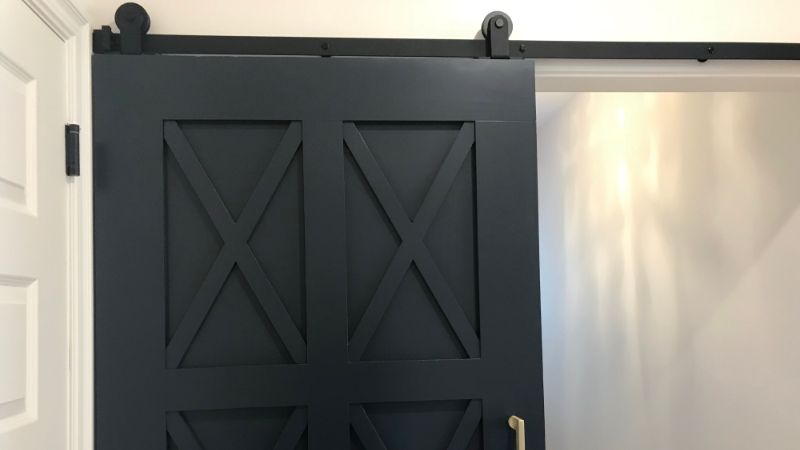
Specialty Wooden Doors
Specialty wooden doors add character and functionality to any space, combining aesthetic appeal with practical design elements. These distinctive options offer solutions for unique architectural needs and spatial constraints.
Sliding Wooden Doors
Sliding wooden doors operate on track systems, moving horizontally rather than swinging open. They save valuable floor space, making them ideal for tight areas where a traditional swing door would be impractical.
These doors come in several variations including pocket doors that slide into wall cavities, barn-style doors that slide along exterior wall surfaces, and bypass doors that slide past each other on parallel tracks.
Materials for sliding doors range from rustic reclaimed wood to sleek, contemporary hardwoods. Many homeowners choose these doors for their space-saving benefits and dramatic visual impact.
Popular Sliding Door Woods:
- Oak (durable, prominent grain)
- Pine (lightweight, affordable)
- Cedar (naturally resistant to moisture)
- Walnut (rich dark tones, premium appearance)
Installation requires proper hardware selection, including rollers, tracks, and handles designed specifically for the door’s weight and usage patterns.
Folding Wooden Doors
Folding wooden doors consist of multiple panels that fold accordion-style when opened. These versatile doors create wide openings that seamlessly connect indoor and outdoor spaces.
Bi-fold doors typically feature two panels that fold together, while multi-fold systems can incorporate numerous panels for spanning larger openings. They’re particularly popular for closets, pantries, and room dividers.
The hardware systems for folding doors include top-hung tracks and bottom guides that ensure smooth operation. Quality hinges are essential for maintaining proper alignment and preventing sagging.
Benefits of Folding Doors:
- Maximum accessibility when fully opened
- Flexible configuration options
- Space efficiency compared to swing doors
- Attractive stacking design when opened
Wooden folding doors can be finished to match existing trim work or stained to highlight the natural beauty of the wood grain. Engineered wood options provide stability and resist warping in variable conditions.
French Wooden Doors
French wooden doors feature multiple glass panes (lites) set within wood frames. This classic design allows abundant natural light to flow between spaces while maintaining visual separation.
Traditional French doors open in the middle and swing outward or inward. They typically come in pairs but can also be installed as single units with fixed sidelights.
The wood frames can be crafted from various species, with mahogany and oak being particularly popular choices for their strength and attractive grain patterns.
French Door Glass Options:
| Glass Type | Features | Best For |
| Clear | Maximum light | Bright spaces |
| Frosted | Privacy with light | Bathrooms |
| Beveled | Decorative element | Formal areas |
| Textured | Visual interest | Entry doors |
French doors often feature decorative molding and raised panels that add architectural interest. Hardware choices like brass handles, cremone bolts, or espagnolette locking systems enhance both security and aesthetics.
Different Type of Wood for Doors
The selection of wood for a door significantly impacts its durability, appearance, and performance in different environments. Each wood species offers unique characteristics that make it suitable for specific door applications and settings.
| Wood Types | Best for | why |
| Teak | Any door, especially outdoors | Very strong and lasts a long time (50+ years). Naturally fights off water, rot, and bugs because of its oils. Looks golden-brown, turning silvery-gray over time. Needs little care. |
| Mahogany | Fancy entry or inside doors | Rich, reddish-brown color that gets deeper. Stays straight and doesn’t warp easily, even with humidity changes. Good for detailed designs and takes stains well. |
| Oak | Strong, traditional-looking doors | Very tough with noticeable grain patterns. White oak is good for outdoor use (better moisture resistance); red oak is popular inside. Dense, so it blocks sound well. |
| Pine | Affordable inside doors | Lighter wood, easy to install. Light color, paints very well. Good for country or casual styles. Needs sealing to protect it and can dent more easily than hardwoods. |
Finishes and Design Options
The appearance of a wooden door can be transformed dramatically through various finishing techniques that enhance both its beauty and durability.
Natural Finishes
Natural finishes celebrate the inherent beauty of wood grain while providing essential protection. Clear polyurethane and varnish offer excellent durability while highlighting the wood’s natural patterns and color variations. These finishes create a transparent protective layer that guards against moisture and UV damage.
Oil-based finishes like tung oil or linseed oil penetrate the wood rather than sitting on top, resulting in a more matte appearance that many homeowners prefer for its authentic look. These finishes require more frequent maintenance but are easier to touch up without complete refinishing.
Wax finishes provide a traditional, soft luster that feels pleasant to the touch. Though less durable than other options, they’re ideal for interior doors in low-traffic areas and can be refreshed easily with occasional reapplication.
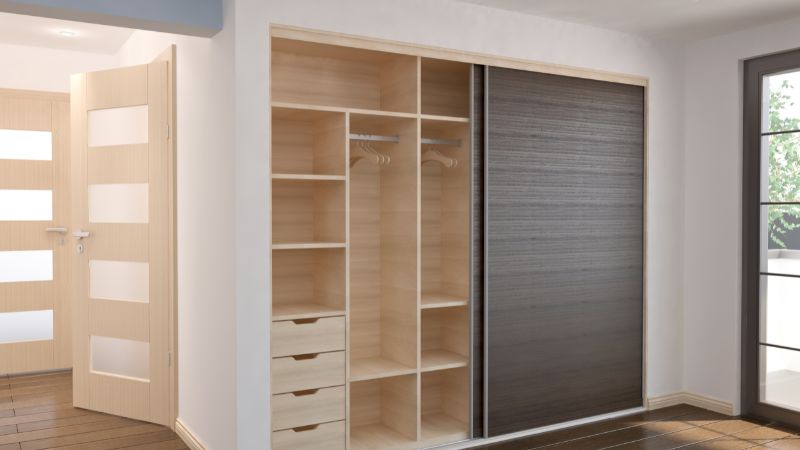
Stained Finishes
Wood stains penetrate the material to alter color while allowing the natural grain pattern to remain visible. They range from light honey tones to rich ebony shades, offering tremendous versatility for homeowners.
Popular stain types include:
- Water-based stains: Low odor, quick drying, environmentally friendly
- Oil-based stains: Deep penetration, rich color, longer working time
- Gel stains: Thicker consistency, excellent for vertical surfaces, minimal dripping
Custom color mixing is available from most manufacturers, allowing for perfect coordination with existing woodwork. Many stains now include UV inhibitors to prevent fading in doors with sun exposure.
For best results, staining should be followed with a clear protective topcoat such as polyurethane or varnish. This additional layer enhances durability and protects the colored finish from wear.
Painted Wooden Doors
Painted finishes offer unlimited color possibilities and can completely transform a wooden door’s appearance. Modern paint formulations provide exceptional durability and resistance to chipping, making them ideal for high-traffic entryways.
Recommended paint types for wooden doors:
- Exterior-grade acrylic latex: Flexible, breathable, resistant to cracking
- Oil-based enamels: Smooth finish, excellent hardness, traditional look
- Chalk paint: Trendy option for distressed or farmhouse styles
Many homeowners opt for contrasting colors between the door’s panels and trim details to create visual interest. Bold front door colors like navy blue, forest green, or bright red have become popular as statement pieces in home exteriors.
Elevate Your Home with Tengyu’s Wooden Doors & Expert Advice
Looking for the perfect wooden door or accompanying hardware for your home? Tengyu offers a range of wooden doors and high-quality door accessories to complement any style.
If you have questions or need expert advice on selecting the ideal wooden door solution, don’t hesitate to contact Tengyu. Our team is ready to provide personalized recommendations and help you find the perfect fit for your needs. Reach out today for expert tips and to explore our product offerings!

